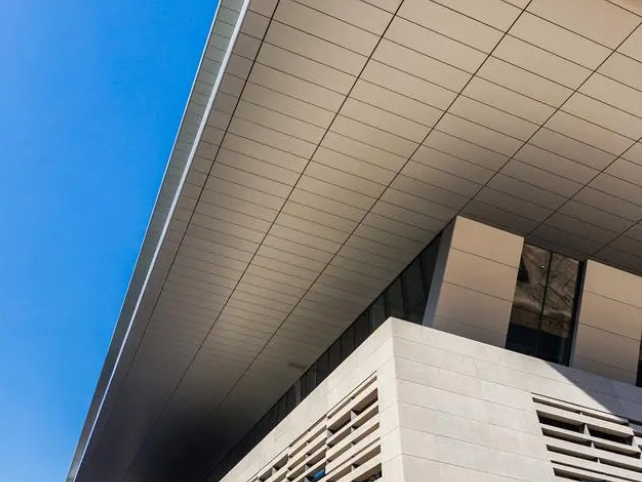Views: 201 Author: Julong Publish Time: 2023-09-01 Origin: aluminum panel systems manufacturer








People's aesthetic needs have improved as society has progressed, and more and more architects have begun to pay attention to the appearance of the building's fashion and innovation. With its superior performance when compared to traditional building materials, aluminum veneer has emerged as the new darling of modern architectural design. The use of aluminum veneer in the construction of buildings allows for unlimited creativity, making it simple to create a fashionable and functional architectural space.
In comparison to traditional building materials such as brick, stone, cement, and so on, aluminum veneer has the advantages of being thin, light, strong, and plastic, as well as being fully capable of performing the work of building materials. The benefits of aluminum veneer are particularly apparent in the following areas:
1. Thin and light. Aluminum veneer is very light when compared to the same volume of other building materials; the unit volume weight is only 2.7g/cm3, which can significantly reduce the weight of the building. This makes aluminum veneer ideal for high-rise and ultra-high-rise building applications.
2. High fortitude. After extrusion, the flexural strength of aluminum veneer can exceed 600MPa, meeting all construction requirements.
3. Strong plasticity. An aluminum veneer can be made into different shapes using punching, bending, splicing, etc., which is very suitable for the decorative design of the building.
4. Corrosion resistance. Aluminum veneer surface after oxidation treatment, can form a dense oxide film so that it has the performance of corrosion resistance. This allows aluminum veneer can be directly exposed to the outdoor environment under certain conditions.
5. Good insulation properties. Aluminum veneer itself has good electrical insulation properties, and can effectively block the penetration of electromagnetic waves, to protect the privacy of the building interior.
6. Easy construction. Aluminum veneer is thin and light and convenient, can be prefabricated according to the design requirements, greatly simplifying the building construction process, and improving construction efficiency.
Aluminum veneer with its unique advantages to become the new darling of architectural design, to provide unlimited possibilities for creative architectural design. Architects can give full play to their imagination through the free shaping of aluminum veneer, a variety of materials and colors of the combination of interpretation, to create a variety of architectural art effects.
An aluminum veneer can be easily made into a variety of shapes, such as arc, folded, waist, etc., with fine node production, can present a streamlined shape, and the overall style of the building and the surrounding environment in harmony. A complex façade can be realized by folding, hammer curving, and molding aluminum panels.
In addition to the basic smooth panels, aluminum veneer can also be made into embossed panels, piano panels, mesh panels, etc., presenting the metal's unique cold and hard aesthetics. It can also be coated with resin topcoat and mixed with other materials to create a variety of visual effects.
The use of different colors of aluminum panels can render a rich tone of the building facade. The oxidized aluminum panels can also remain colorfast for a long time, making the building color more durable. Spraying, baking, anodizing, and other technologies provide more possibilities for the application of aluminum color.
Aluminum veneer can be designed to be either light translucent or opaque. A translucent aluminum veneer can create a space atmosphere of changing light and shadow; opaque can make the external surface of the building present a sense of three-dimensionality and hierarchy.
Aluminum veneer's lightweight volume and high load-bearing capacity allow it to be used to create a wide range of stunning architectural designs. Brilliant aluminum facade, and light and elegant aluminum roof, all of which highlight the aluminum veneer's magical power. A small piece of aluminum can be combined to produce such an eye-catching visual effect.
Aluminum veneer, as a metal material, not only has a bright and shiny appearance, but its inner quality is exceptional. Aluminum veneer has high strength, corrosion resistance, and excellent electrical and thermal conductivity, allowing it to be widely used in electronic products, transportation, energy and environmental protection, and other high-tech fields. Although it is a small piece of aluminum, it has excellent material properties.
Aluminum veneer is also becoming increasingly popular among contemporary designers. They use aluminum veneer to create stunning art installations or fold out of the magic of the three-dimensional garden, and each piece of work delves into more aluminum veneer possibilities. Because the design of the hammer and bloom colorful artistic inspiration, a piece of monotonous metal.
Visible, aluminum veneer for the building provides a rich and varied material language, making it the ideal choice for creating a stylish building appearance. Aluminum veneer will shine in future architectural designs and continue to surprise us. I believe that as architects' creativity grows, more and more creative fashion buildings will emerge!
Are Aluminum Composite Panels Weather-Resistant in Singapore’s Climate?
Is Aluminum Composite Panel Section Waterproof And Fire Resistant?
Is Aluminium Composite Panel Wall Cladding Worth The Investment?
Are Aluminium Composite Panels Weatherproof in The UK Climate?
Can You Import Aluminium Composite Panel Textures into SketchUp Easily?